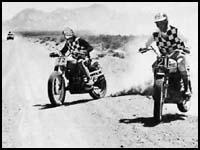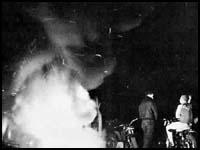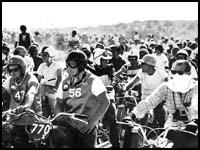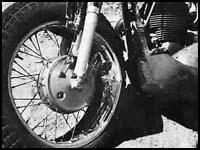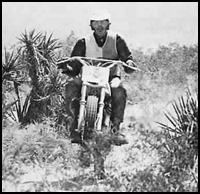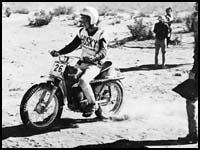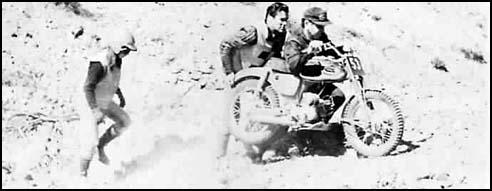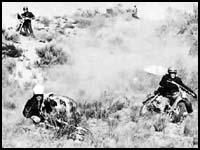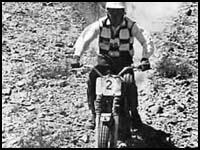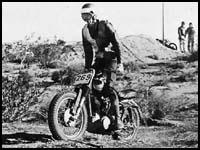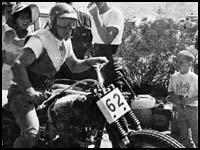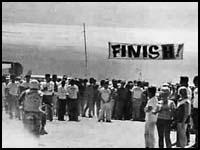|
Remember
When...
|
Some time ago, I had a messy job to do, but one that turned out to be more pleasant than I had figured. I had to go through a bunch of old file cabinets, separate the junk from the good stuff and put the good stuff in the shiny new file cabinets.
 The banner drops and a herd of Huskys, Bultacos, Triumphs, Beezers and assorted ancient iron head for the smoke bomb. |
A few of those old file cabinets had a thick layer of dust on the surface, silent testimony to the fact that they hadn't even been opened in years.
The first few contained nothing exciting, unless you call old manuals for Gileras and Lambrettas pulse-raising material. But the third musty old cabinet held a treasury of photos from decades ago.
I sat down and went through the collection. Gad; There were shots of funny looking movies stars riding Harleys, glossy photos of Royal Enfields. Vincents and other oldies, prints of ancient Hondas with giant humpbacked tanks, grizzled dudes on touring bikes smiling tight-lipped at the camera, 8 x l0s of various step through econo bikes and lo! ... what's this!!! A giant thick section of desert racing shots just bristling with photos of big 650 Triumphs and Grand Old Singles.
 Hole shot of a lifetime; while everyone else is still kicking over their machines, a Checker gets off the line early by reading the drop of the banner just right. |
I spread the photos out, and nearly did a double-take. A few people walked over and peeked at the photos, and could not hold back the ooooohs and aaaaahs.
 The start! Wide open desert in front and a hundred miles to go. |
"Hey! Lookee that. It's an old Greeves MX3 Challenger. And right next to it, a 441 BSA Victor!"
"Hooeee!" went another voice, "That old sled must've weighed in at over 400 pounds. You had to be a regular iron - man back in those days just to ride one of those suckers."
As it turned out, I spent most of the day sitting back there gazing at those great old photos.
Yep, those were the days when things were a lot tougher. But they were a lot simpler, too. Nobody thought much about magnesium this, or aluminum that. Just take your old street bike, strip the thing down, put on some wide bars and dirt tires and go racin'.
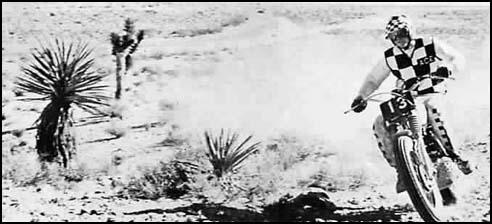 Al Baker-of Baja fame-was one of the youngest desert winners ever to hit the scene. Eddie Mulder was THE youngest. |
Nowadays, the winning desert machines are running 12-plus inches of travel in the rear, a foot up front, have five and six speed gearboxes, and still weigh under 240 full of gas, with tools and spares in place.
Back in the old days, a winning desert bike had maybe three inches in the back, four and a half in the front (some of it side to side play), a four speed, street ratio gearbox and weighed in around 395 dry and 435 ready to race.
Trick, back then, was an overlay sprocket, a padded seat, sidecar springs in the forks and a thick aluminum fork brace.
The days of the great desert sleds are long gone, but even now, when riders see an old fashioned desert 650 on the starting line, they look at it with big eyes and wonderment.
Yes. That's when bikes were made of iron and the riders were, too. So, take a trip back with us and enjoy.
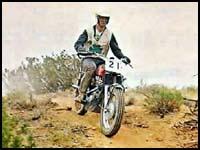 A 750 Norton and a two-digit number plate were signs of a savvy rider back then. |
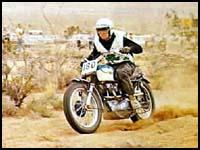 A Shamrock member churns through the Mojave sand on his near-stock Triumph. |
